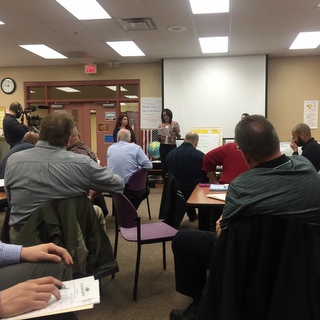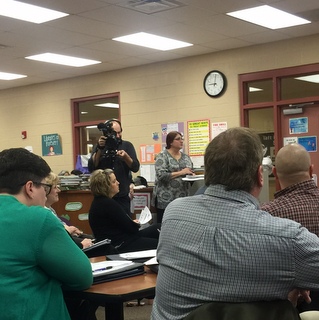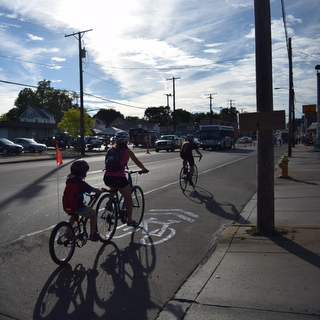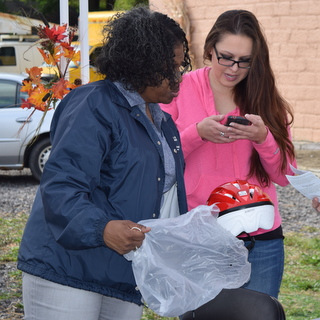Business leaders, quasi-government organizations, city administrators, elected officials, institutions such as Youngstown State University, neighborhood groups – even a long-ago president of the United States — all share in the credit of rebuilding the appeal and image of the city.
That was the overarching message of the Youngstown Warren Regional Chamber’s Good Morning Youngstown breakfast held at Stambaugh Auditorium Friday.
Speaking at the event were Gregg Strollo, partner at Strollo Architects; John Hyden, executive director of YSU’s facilities and support services; Matt Pagac, general manager of Stambaugh Auditorium; and Abby Beniston, the city’s code enforcement superintendent.
In particular, the attractions in the city’s central business district that many enjoy today are the product of hard work and cooperation that began decades ago, Strollo told about 200 attendees at the breakfast.
“There were people that had the commitment to put forward the effort to plan appropriately,” said Strollo, whose company recently renovated the landmark Wells Building downtown as its new offices. “It started with something called the Youngstown Revitalization Foundation in the late 1970s.”
This led to the creation of the Youngstown Central Area Community Improvement Corp., which helped facilitate cooperation between the public and private sectors to redevelop dilapidated downtown buildings, he noted. “The CIC was 60% private sector and 40% public sector,” he recalled, as the organization acquired a large inventory of vacant downtown buildings earmarked for redevelopment.
“Eventually, through the hard work of those folks, through several mayors, they made the commitments necessary to get these projects turned around,” Strollo said. “It took a while; it moved glacially.”
Since then, millions of dollars of investment have poured into the central business district. In December, Strollo completed a $5 million project that converted the Wells Building into a modern office for the architectural firm on the ground floor, and 12 apartments on the top three floors.
Add to this the redevelopment of the Federal Building, the creation and expansion of the Youngstown Business Incubator, the construction of new government buildings, a slate of new taverns and restaurants, and ongoing reinvestment in longtime institutions such as a $5 million renovation at the downtown YMCA, and the change is transformational.
And, it was a phone call from a lame-duck president with just weeks left in office that helped pave the way for developing what is today an important corridor of downtown, Strollo noted.
In 1980, after Jimmy Carter had lost the presidential election to Ronald Reagan, he reached out to Democratic Party faithful in Youngstown. “He made a call to some Democratic Party folks that had been very supportive of him over the years, and asked if there was anything he could do to help Youngstown in his last days,” Strollo recalled.
Carter helped secure for the city what was then called the Railroad Abandonment Corridor – a strip that runs between Commerce Street and Wood Street.
“It was a real barrier between the city and the university, and he was able to turn that over to the city for redevelopment,” Strollo said. The transaction helped pave the way for the creation of the Ohio Historical Center for Industry and Labor, redevelopment of the Erie Terminal Building and construction of a new U.S. Bankruptcy Court building.
Furthermore, the deal cleared the way many years later for extending Phelps Street, which now serves as a direct connection between downtown and YSU.
YSU’s Hyden said that connectivity between downtown and the university is critical to the city’s character and success.
YSU, he said, is in the midst of its own building projects as well. Most recently, the attention has been to improve the quality of student life and success, Hyden said, noting it’s an important component of YSU President Jim Tressel’s administration.
Two major housing projects are under way. Hallmark Campus Properties’ University Edge student housing complex just off Fifth Avenue is underway and Phase I should be open by the summer of 2016. Phase II of the project was approved recently by YSU trustees.
Preliminary work is also in place for another student housing development, The Enclave, at the corner of Wick and Lincoln avenues. “This is being developed by LRC Realty, and is designed for 168 beds as well as a retail outlet,” Hyden said. Construction should begin this summer and the project completed by fall semester 2017.
Additional plans call for the university to redevelop fields west of Fifth Avenue, directly across from Stambaugh Stadium and near the new soccer and softball fields. “We plan in the future to have additional playing fields and hopefully a tennis complex in that area,” he said.
Other initiatives across the city target blight and vacant housing, said Abby Beniston, the city’s code enforcement superintendent.
She told attendees that the city is hampered with roughly 3,900 vacant dilapidated structures within the city, and City Council over the past decade has devoted millions of dollars to demolish them.
Beniston said that the city has received help from an environmental sanitation fund it established for the sole purpose of removing blight. “Youngstown was the first municipality in the state of Ohio to establish an enterprise fund solely dedicated to demolition and public nuisances in the city of Youngstown,” she said.
The city has also worked closely with the Mahoning County Land Bank and other resources to help repurpose vacant and blighted parcels.
Among the more recent collaborations is with the Youngstown Air Reserve Station’s 910th Air Wing Civil Engineer Squadron through the air base’s community partnership program.
The program is sponsored by the U.S. Department of Defense and is designed to establish partnerships with the community and the base to combat blight.
Since July, air base personnel have helped demolish 80 homes in the city, 17 of of which were around the Taft School district. Since that district has the highest rate of pedestrian commutes to and from school, it was important that the area was targeted for cleanup, she said.
Each year, the city razes about 500 vacant houses total.
“The blight remediation program we have with the air base is the first partnership in the nation where the Department of Defense has allowed their airmen and women to take on a project that included demolition,” she said. “We’re hoping any day that the funding is approved and they’ll be back this spring.”
To read the whole story from The Business Journal, please click here.
 ,
,  ,
,  ,
, 
 ,
,  ,
,  ,
, 

 ,
,  ,
, 